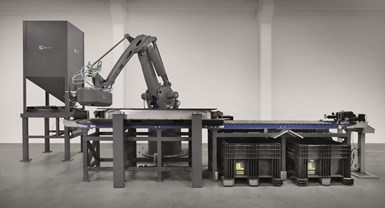Optimized Castings, Fast Turnarounds with Sand 3D Printing
IMTS 2022: ExOne’s S-Max Flex pairs industrial robots with an end effector printhead design that deposits binder into a 1,900 × 1,000 × 1,000 mm (74 × 39 × 39") telescoping build box that grows as the parts are built layer by layer.
3D printing sandcasting molds and cores straight from CAD files enables foundries to eliminate the months-long lead times and high costs of traditional patterns and core boxes. The design freedom of additive manufacturing (AM) also enables designers to develop parts made with the reliable casting process — creating complex, consolidated geometries that enable lightweighting and optimized part performance not possible with traditional processes.
The S-Max Flex from ExOne (a division of Desktop Metal) pairs industrial robots with an end effector printhead design that deposits binder into a 1,900 × 1,000 × 1,000 mm (74 × 39 × 39") telescoping build box that grows as the parts are built layer by layer.
Desktop Metal’s high throughput Single Pass Jetting (SPJ) technology is said to deliver a build rate (up to 115 L/hr.) for quick and reliable production, enabling more efficient operation in times of ongoing labor shortages. This technology also promotes a fast return on investment, according to the company. The system has a modular footprint and processes standard silica sand with furan binders and delivers final parts with a dimensional accuracy of ±0.5 mm.
Industries beyond metal casting can also take advantage of the printer’s large form and ability to binder jet a variety of powders, ExOne says. Infiltrated sand tooling for plastic thermoforming, composite layup and sacrificial tooling applications are able to be printed on S-Max machines.
Related Content
-
How this Job Shop Grew Capacity Without Expanding Footprint
This shop relies on digital solutions to grow their manufacturing business. With this approach, W.A. Pfeiffer has achieved seamless end-to-end connectivity, shorter lead times and increased throughput.
-
CAD/CAM System Requirements: An Overview
CAD/CAM programs are among the most demanding kinds of computer software. Smooth operation requires careful consideration of computer specifications.
-
Fearless Five-Axis Programming Fosters Shop Growth
Reinvestment in automation has spurred KCS Advanced Machining Service’s growth from prototyping to low-and mid-volume parts. The key to its success? A young staff of talented programmers.











.png;maxWidth=300;quality=90)


